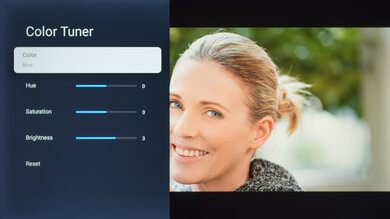We used the following calibration settings to review the 65-inch Hisense A65K (65A65K), and for the most part, we expect them to be valid for the 43-inch (43A65K), 50-inch (50A65K), 55-inch (55A65K), and the 75-inch (75A65K) models as well.
These settings are meant to provide a starting point; they're not meant to be copied 1:1. They provide the most accurate image in a dark room, but you should adjust them to match your preferences and viewing conditions.
General Settings
Basic SDR Picture Settings
For SDR content, there are a few different preset picture modes you can choose. We used the 'Theater Night' Picture Mode because it's the most accurate out of the box and allows for the most customization.
Unlike most TVs, there's a separate menu for the backlight brightness. You should adjust the Backlight Level to your specific viewing conditions, and changing this doesn't have any impact on the overall picture quality. The Brightness setting in the Picture menu doesn't adjust the backlight level; we didn't change this setting for our calibration.
Advanced SDR Picture Settings
You can adjust a few settings on the Picture settings page to optimize the image to your preference. We set the Contrast to '39', Color to '50', and Tint to '0'. Sharpness was set to '10', as that delivered the best results with our test clip without adding oversharpening.
In the Advanced Settings tab, we chose the 'Low' Color Temperature because it's closest to the target color temperature of 6500K. We left Noise Reduction, Digital Noise Reduction, and Active Contrast disabled as they can cause a loss of fine details in higher-quality content. We also left the Color Space set to 'Auto', so the TV doesn't appear over-saturated when playing SDR content.
HDR
When you start playing HDR content, a small HDR icon appears in the picture settings menu. When HDR is enabled, some settings change automatically, including the Backlight Level, which increases to 'Max.' We used the 'FILMMAKER' Picture Mode for HDR, the 'Low' Color Temperature, and left the other settings as-is. Adjust the settings to find the image you find is best. With most sources, HDMI Format has to be set to 'Enhanced format' for HDR to work.
HDR White Point
The following are the results of calibrating the white balance of our unit to 6500K in HDR. They are provided for reference and shouldn't be copied as the calibration values vary per individual unit, even for the same model and size as the TV we reviewed, due to manufacturing tolerances. If you want to try them, you'll need to enter all values shown, as all of them are active at the same time. If you end up with worse picture quality, simply reset them to the default values.
Motion Settings
Although we disable most motion settings for most of our tests, you should adjust these to whatever looks best for you. Some settings, like motion interpolation, may need to be adjusted depending on the specific content you're watching.
Motion Interpolation
If you want to enable motion interpolation, set Motion Enhancement to 'Custom' and adjust the Judder Reduction and Blur Reduction sliders. You should adjust these settings to your preferences, and you may need to adjust them depending on the specific content you're watching.
Judder
This TV automatically removes judder from 24p and 60p embedded sources; no additional settings are needed. It can't remove judder from 60Hz interlaced sources. Many cable boxes support either 720p or 1080i, so if that's your case, make sure you set your cable box to output 720p for a judder-free experience.
Gaming Settings
Very few changes are required for a great gaming experience from the base SDR and HDR settings. When you start gaming, it's best to switch to the 'Game' Picture Mode to get the lowest input lag and use the same settings for SDR or HDR. For most recent consoles, set the HDMI Format to 'Enhanced' for 4k @ 60Hz gaming. If you set Instant Game Response to 'Auto', the TV will automatically switch to the 'Game' Picture Mode, so you don't have to remember to change modes when you start gaming.
PC Gaming
Unlike TVs from most other brands, no special settings are required for PC use. Just make sure you're using the 'Game' Picture Mode and set HDMI Enhanced Format to 'Enhanced Format' for the input you're using. These settings are required for low input lag and for chroma 4:4:4 support, which is important for text clarity.
ARC/eARC
This TV supports eARC passthrough on HDMI 3, so you can pass high-quality audio to a compatible receiver. For eARC to work with Dolby Atmos formats, set Digital Audio Out to 'Auto'.
Other Settings
Accessibility Settings
This TV has a good selection of accessibility features. It supports automatic closed captioning, text-to-speech, and an experimental high-contrast text mode, just to name a few. There's also an option to disable the picture entirely, leaving the audio, which is great if you want to listen to music and don't need the screen on.
White Balance Settings
The following are the results of the white balance and colorspace calibration on our unit. They're provided for reference, and you shouldn't copy them, as the calibration values vary per individual unit, even for the same model and size as the TV we reviewed, due to manufacturing tolerances. If you want to try them, you'll need to enter all values shown, as all of them are active simultaneously. If you end up with worse picture quality, simply reset them to the default values.



















































































